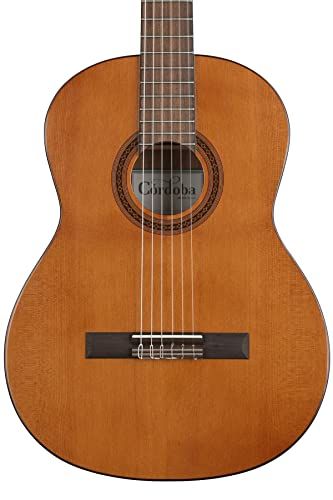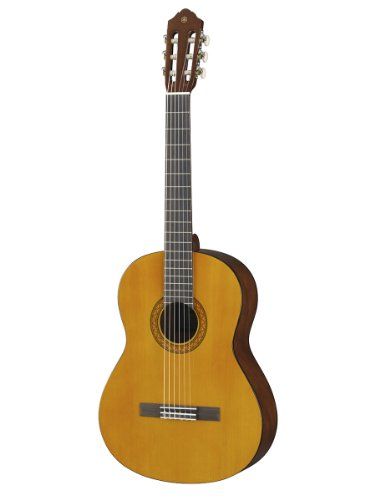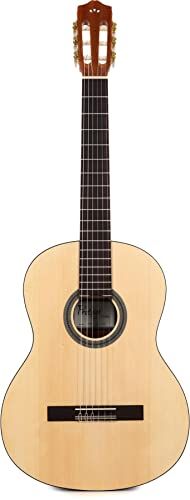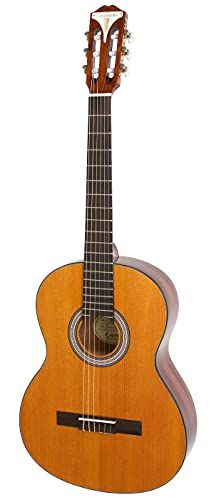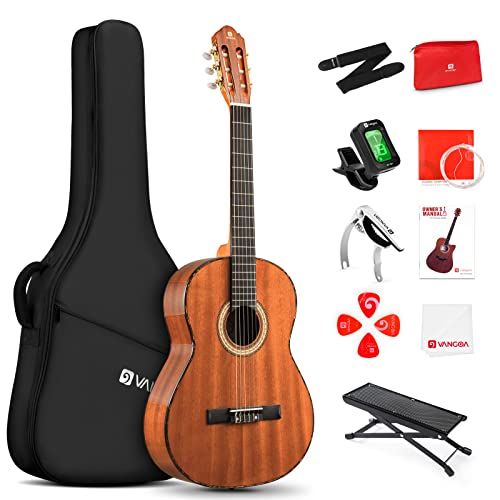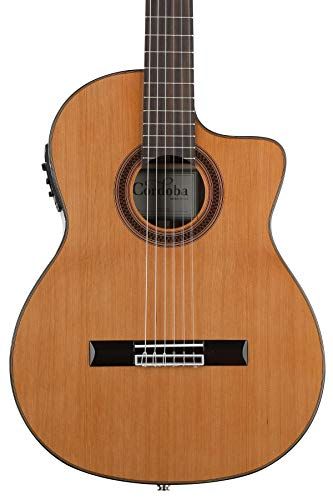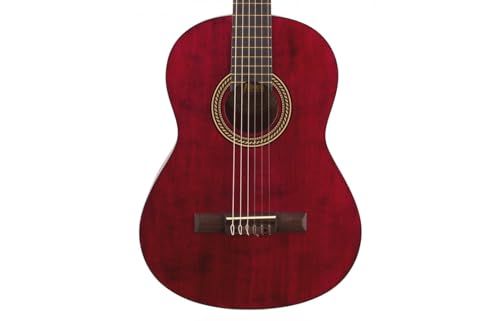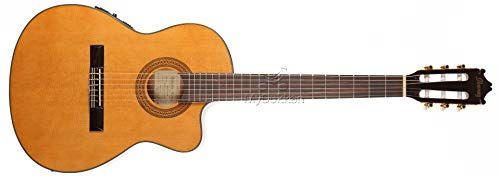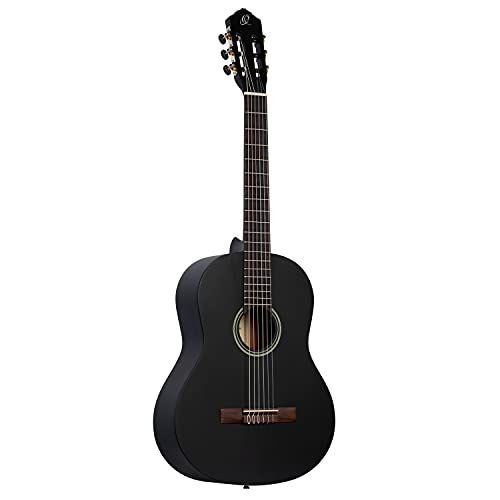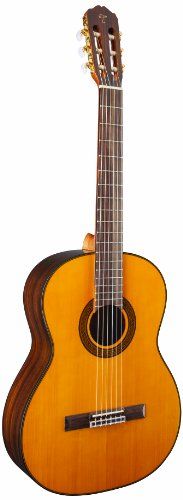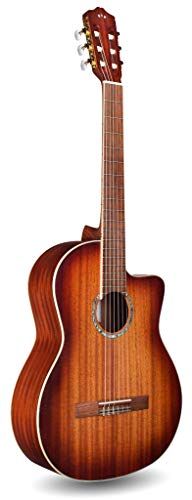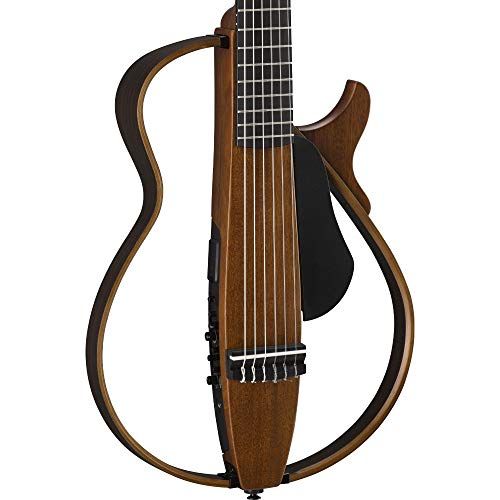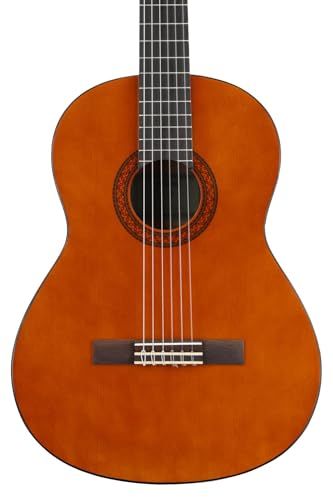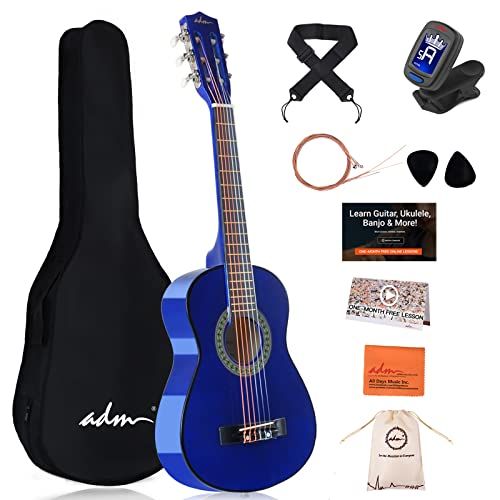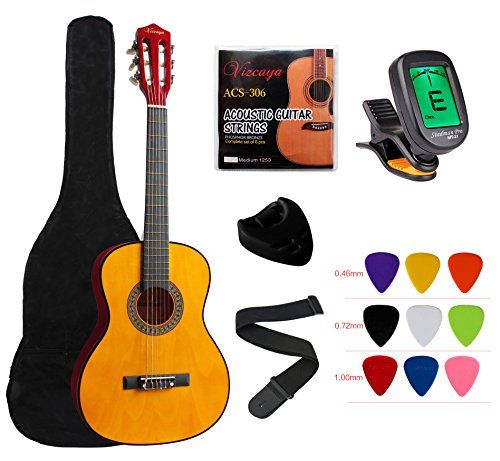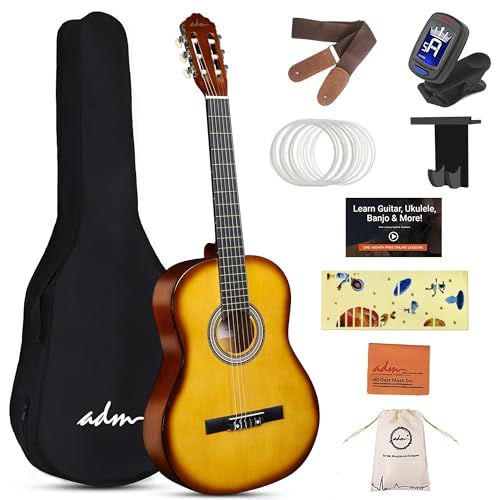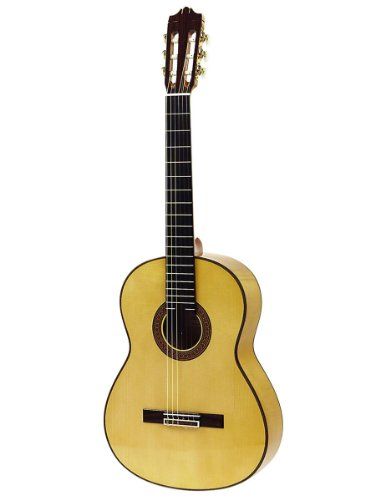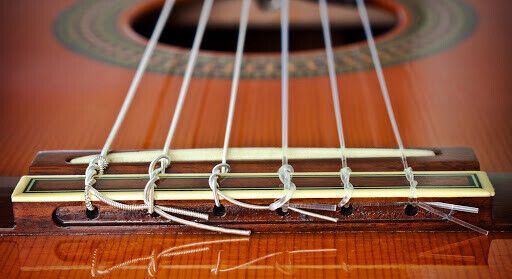
Classical and nylon-string guitars have a long and storied history dating back hundreds of years. They emerged in the late Renaissance and Baroque eras as a softer-sounding alternative to the steel-string and archtop guitars that were also becoming popular during that time.
Classical guitars are acoustic and have nylon or other non-metal strings, resulting in a warm, full-bodied tone perfect for playing pieces from famous composers like Bach, Mozart, and Beethoven. The term "classical guitar" can refer specifically to the modern classical guitar that took shape in the late 19th century, or more broadly to any acoustic, nylon-stringed guitar.
Unlike steel-string acoustic guitars, classical guitars have a wider neck to support the added tension from the nylon strings. They also utilize a special bracing system inside to produce richer bass notes and project sound more effectively. The nylon strings give them a softer, mellower tone that lends itself well to genres like classical, flamenco, bossa nova, and Latin music.
Today, classical guitars remain popular for students first learning guitar, as the wider neck and softer strings are easier on young hands. The genre has also left a lasting mark on music, with classical guitar techniques influencing many modern plucking and fingerpicking styles. Whether you're a classical purist or simply want to expand your musical horizons, the classical guitar's beautiful sound and extensive repertoire offer lifetimes of enjoyment.
Construction of Classical and Nylon-String Guitars
Classical and nylon-string guitars differ in their construction and components compared to steel-string acoustic guitars. Some key differences include:
Woods Used - Classical guitars typically use a spruce or cedar top with mahogany or rosewood back and sides. The wood combination produces a mellow, warm, rounded tone.
Nylon Strings - In place of steel strings, classical guitars use nylon strings. Nylon produces a softer, warmer sound compared to the brighter tone of steel strings. The decreased tension of nylon is also easier on the hands.
Wider Necks - Classical guitars have wider necks than steel-string acoustics, usually around 52-54mm at the nut width. This allows for more space between strings and makes it easier to play with the correct classical technique.
Wider Fretboards - Similarly, classical fretboards are a bit wider to accommodate the nylon strings and proper technique. Many classical guitars have fretboards nearing 3" in width.
So in summary, classical guitars diverge with their mellower wood construction, nylon strings with reduced tension, and slightly wider necks and fretboards to facilitate the proper playing style. These attributes lend to the smooth, rich tone that classical guitars are known for.
Playing Styles and Techniques
Classical and nylon-string guitars are associated with fingerstyle techniques that allow for nuanced expression. Common right hand techniques include:
Rest stroke
- Plucking the string with the fingertip and letting it come to rest on the next string. This produces a fuller, louder tone.
Free stroke
- Plucking the string and allowing the finger to move freely after the pluck. This creates a lighter, softer sound.
The left hand is responsible for pressing the strings to the fretboard to produce different pitches. The curved nails of the right hand in combination with fingerstyle plucking enable the guitarist to play with dynamics and articulation to shape the tone and phrasing.
Common left hand techniques include:
Vibrato
- Shifting the finger back and forth on a fretted note creates an expressive, wavering sound.
Slurs
- Hammer-ons, pull-offs, and legato phrasing seamlessly connect notes through the left hand movements.
Right and left hand techniques are coordinated to allow classical guitarists to play polyphonic music, melodies, and accompaniment simultaneously. The positioning is characterized by the left wrist being straight and right arm resting over the body of the guitar. This facilitates free movement of the plucking hand and fingers pressing the strings.
Proper technique develops through diligent practice of scales, etudes, and repertoire to train muscle memory and kinesthetic abilities. Master classical guitarists utilize these techniques to create nuanced performances.
Tone and Sound Profile
Classical and nylon-string guitars are known for their distinct tonal qualities that differ from their steel-string acoustic counterparts. The nylon strings have a softer and mellower tone that emphasizes warmth and richness of the guitar's voice. The sound profile tends towards the bass and mid-range rather than the bright treble of steel-strings.
The nylon strings and construction allow for a wide dynamic range. Guitarists can play with nuance and subtlety, from the most delicate pianissimo passages to dramatic forte moments. The guitar is very responsive to different attack styles, allowing color and expression. The resonance of the guitar body enhances sustain.
Overall, classical and nylon-string guitars excel at providing a warm, rich, nuanced, and sensitive voice that brings out the emotive qualities in guitar music spanning various genres and time periods. The expansive dynamic range allows guitarists to interpret pieces with the subtleties of expression the composers intended.
Most Common Classical Guitar Shapes
Classical guitars come in a variety of shapes and sizes to accommodate different playing styles and needs. Here are some of the most popular and commonly seen classical guitar body shapes:
Concert/Orchestra Model
The concert or orchestra model is the most common and traditional classical guitar shape. It features a wide fretboard and lower action to accommodate more intricate fingerstyle playing. The body shape is hourglass with a lower bout that is larger than the upper bout. This provides excellent projection and volume for concert hall playing. The neck joins the body at the 12th fret. Popular luthiers that construct the concert model include Ramirez, Hauser, Fleta, and many others.
Grand Concert Shape
As the name suggests, the grand concert shape is a larger version of the traditional concert model. It provides an even fuller and richer tone thanks to the bigger body size. The lower bout is particularly large to increase bass response. The grand concert shape is ideal for professional concert guitarists who need maximum volume and projection. Leading luthiers of this shape include Manzer, Yulong Guo, and José Ramírez.
Petite Bouche Shape
The petite bouche shape, sometimes called salon guitar, is essentially a smaller version of the concert model. It has a narrower waist and a smaller and more delicate appearance. The petite bouche shape produces a more focused and intimate tone. It's ideal for playing in smaller spaces and practicing. Prominent luthiers of the petite bouche style include Kenny Hill and Ruck.
Best Woods for Classical Guitars
When it comes to the woods used in classical guitars, there are some tried and true combinations that have stood the test of time. The most important factors in choosing woods for classical guitars are tone, durability, stability, and aesthetics. Here are some of the most commonly used woods:
Spruce tops - The thin top wood has the most influence on the sound. Spruce is bright and responsive, with good projection and dynamic range. The most sought-after spruce tops come from old growth European Alpine forests.
Cedar tops - Cedar is a popular alternative to spruce, offering a darker, warmer sound. It lacks some of the crispness and clarity of spruce, but makes up for it with a sweet, refined tone.
Indian Rosewood backs/sides - Indian rosewood, sometimes referred to as Dalbergia latifolia, is a dense tropical hardwood prized for its beauty and tonal properties. It has a deep bass resonance while still retaining excellent note separation.
Mahogany backs/sides - Mahogany backs and sides provide a nicely balanced sound across the tonal spectrum. It has clear trebles, good sustain, and complexity in the mid-range. Mahogany is a great choice for players looking for an affordable option without sacrificing too much tonal nuance.
Ebony or rosewood fingerboards - Ebony is the traditional wood used for classical guitar fingerboards. It is extremely dense and durable. Rosewood is also commonly seen and has similar tonal characteristics to ebony. Both woods help amplify and project the sound coming from the strings.
The combination of spruce or cedar tops with rosewood or mahogany back and sides is a tried and tested formula for great sounding classical guitars. The material quality and workmanship of the luthier will determine just how good the final instrument can be.
Highlights of Repertoire
The classical guitar repertoire spans many centuries, from the Renaissance period through to contemporary works by living composers. Here is a brief overview of some of the most famous and influential pieces written for the classical guitar.
During the Renaissance, composers such as Luis de Narváez wrote works for the four-course guitar, an ancestor of the modern classical guitar. In later Baroque and Classical periods, guitar works became more prominent. Composers like Gaspar Sanz and Mauro Giuliani helped establish the guitar as a solo instrument.
Some of the most famous classical guitar pieces come from the Romantic period in the 19th century. Composers like Fernando Sor and Francisco Tárrega expanded the repertoire and pushed the technical boundaries of the instrument. Sor's etudes like Op. 6 No. 11 are standards in classical guitar pedagogy. Tárrega's famous "Recuerdos de la Alhambra" shows off the guitar's lyrical qualities.
In the 20th century, Andrés Segovia was a towering figure who inspired composers to write new works for the guitar. Pieces by Heitor Villa-Lobos, Manuel Ponce, and Joaquín Rodrigo remain pillars of the classical guitar canon. Rodrigo's "Concierto de Aranjuez" brought the classical guitar to a wider audience.
Modern composers are still expanding the repertoire, from Leo Brouwer's studies to Andrew York's "Sunburst." There are centuries of great music to explore written for this versatile and expressive instrument. Discovering both famous standards and lesser-known gems makes being a classical guitarist endlessly rewarding.
Most Renowned Luthiers
The classical guitar as we know it today owes much of its design, construction techniques and innovations to a few pioneering master luthiers. Some of the most influential are:
Antonio de Torres - Known as the "Stradivarius of the guitar", Torres elevated the classical guitar in the mid-19th century by increasing the size of the body, introducing fan strutting inside, and constructing the bridge based on mathematical calculations. His designs established the shape and proportions of the modern classical guitar.
Hermann Hauser - Building upon Torres' techniques in the early 20th century, Hauser introduced further innovations like the asymmetrical top bracing pattern still seen today on classical guitars. The "Hauser School" of luthiery influenced generations to come.
Daniel Friederich - His guitars combined the Spanish style of Torres with elements of German and French luthiery. Friederich introduced a seven fan strutting pattern inside his guitars that improved resonance and projection.
Ignacio Fleta - Fleta took inspiration from Torres and Friederich to create his own school of design with unique bracing and body shapes. His students, like José Ramirez, helped continue his legacy.
Manuel Rodriguez - Known for high quality but affordable classical guitars, Rodriguez introduced the idea of production line lutherie while still crafting instruments by hand. This combination of craft and efficiency allowed more players access to fine guitars.
The technical skills, experiments and lifelong dedication of these luthiers helped elevate the modern classical guitar to new heights and endowed it with the signature voice it carries today. Their names will be forever linked to the history and development of the classical guitar.
Buying Considerations
When looking to purchase a new classical or nylon-string guitar, there are several factors to consider:
New vs. Used Models - While used instruments can sometimes be found at a lower cost, they also come with more unpredictability. With a new guitar, you know exactly what you're getting and have the full warranty and return period if needed. That said, used instruments can be a great value if they are still in good condition. Examine used guitars closely.
Price Ranges - Classical and nylon-string guitars span a wide range of prices, from around $100 for basic starter models to over $10,000 for high-end concert guitars from elite luthiers. In general, guitars under $500 will be machine-made with laminated woods, while anything above $1000 will be completely hand-crafted from solid tonewoods. Expect to pay $700-2000 for a good quality classical guitar built from solid woods.
Testing the Instrument - When evaluating any new or used classical guitar, there are several factors to check:
Playability - Are the strings a comfortable height above the frets? Is the neck easy to navigate? Are there any dead spots or buzzing?
Tone - Strum the guitar and listen for a rich, clear tone without too much bass or tinny treble. Voice each individual string to check for any defective strings.
Intonation - Test up and down the neck to ensure notes fretted at the 12th fret sound the octave of the open string. Poor intonation makes it hard to play in tune.
Construction - Examine the overall build quality and materials. Solid woods and clean craftsmanship are ideal.
By carefully considering these buying factors, you can find the best classical or nylon-string guitar to match your playing style and budget. Be sure to try before you buy!
Popular Classical Guitar Brands
Many renowned modern guitar makers craft high-quality nylon-string and classical guitars. Here are some of the most popular and well-respected brands in the market today:
Cordoba Guitars
Founded in 1997, Cordoba is a fast-growing Spanish guitar manufacturer known for its impressive nylon-string instruments. They offer a wide range of classical and flamenco guitars at various price points. Some of their most popular models include:
C7 - An excellent beginner's guitar made with solid Canadian cedar top and mahogany back and sides. Retails around $329.
C9 - A hand-made guitar with solid Canadian cedar top and Indian rosewood back and sides. Priced around $659.
C12 - Equipped with a solid Canadian cedar top and Indian rosewood back and sides. Cordoba's best-selling model around $999.
Yamaha
The Japanese musical instrument giant has been producing classical guitars since the 1960s. Yamaha offers consistent quality and great value for money. Some of their best classical guitar models include:
C40 - Yamaha's most affordable model with spruce top and meranti back and sides. Retails for around $169.
C80 - A mid-range model with solid spruce top and rosewood back and sides. Priced around $449.
GC22C - A premium handcrafted nylon-string with solid cedar top and rosewood sides and back. Costs approximately $999.
Kremona
Based in Bulgaria, Kremona specializes in making high-quality classical guitars. They use top tonewoods like cedar, spruce and rosewood. Here are two of their most sought-after models:
Sofia - Made with solid Bulgarian spruce and flamed maple back and sides. Their mid-range model retailing for $725.
Rosa - Handcrafted from solid cedar top and East Indian rosewood. Their top-tier model priced around $1399.
The brands above consistently garner excellent reviews and recommendations from classical guitarists. While not budget options, their instruments deliver professional grade sound, playability and aesthetics. Most models retain their value well if players decide to upgrade down the line.
Classical & Nylon-String Guitars comparison
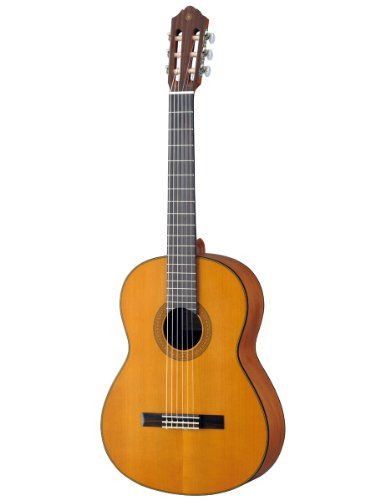 |  | 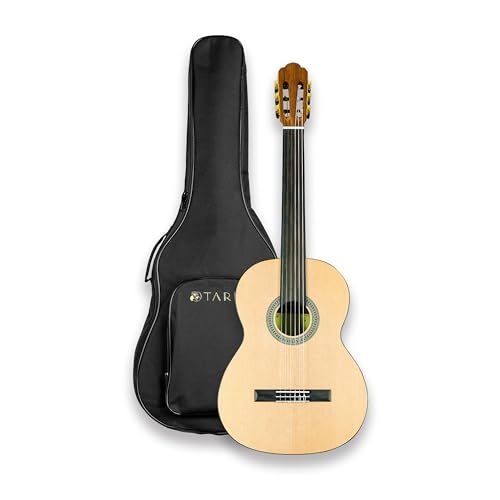 | 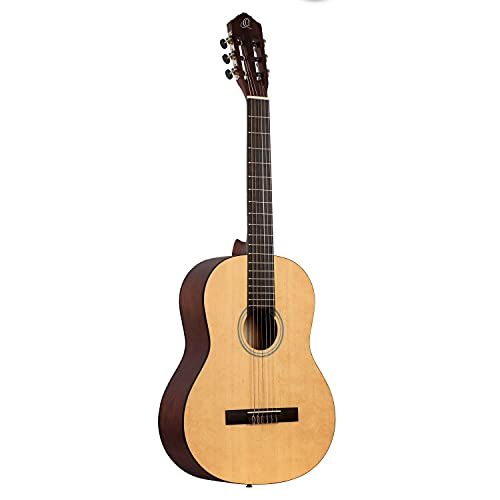 | 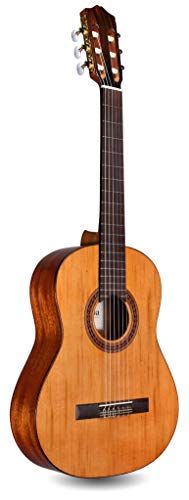 | |
|---|---|---|---|---|---|
| Model | Yamaha CG122MCH | Ortega Guitars RST5 | TARIO LC-220FL-L | Ortega Guitars RST5M | Cordoba GUCLCOR-02684 |
| Back Material | Nato Wood | Catalpa | Spruce | Catalpa | Mahogany |
| Body Material | Wood | Catalpa | Spruce | Catalpa | Mahogany |
| Color Name | Cedar | Black | nature | Black | Natural |
| Fretboard Material | - | Walnut Wood | Laurel Wood | Walnut Wood | Pau Ferro Wood |
| Guitar Bridge System | Fixed | Fixed | - | Fixed | - |
| Guitar Pickup Configuration | - | - | no pickup | - | - |
| Instrument Key | C | - | - | - | - |
| Is Discontinued By Manufacturer | No | No | - | No | No |
| Item Model Number | CG122MCH | RST5 | LC-220FL-L | RST5M | GUCLCOR-02684 |
| Item Weight | 4.99 pounds | 4.54 pounds | - | 4.62 pounds | 3 pounds |
| Material Type | Nato Wood | - | - | - | - |
| Musical Style | - | Lessons, Student, Classical, Folk, Pop, Songwriter | - | Lessons, Student, Classical, Folk, Pop, Songwriter | - |
| Neck Material Type | - | Mahogany | Okoume Wood | Mahogany | Mahogany |
| Number of Strings | 6 | - | - | - | - |
| Product Dimensions | 40.94 x 19.25 x 5.39 inches | 40 x 15 x 4.5 inches | - | 40 x 15 x 4.5 inches | 46 x 8 x 18 inches |
| Proficiency Level | - | Beginner | - | Beginner | - |
| Scale Length | 25.6 Inches | - | - | - | 22.8 |
| Size | Classical | - | Left hand | - | 1/2 |
| String Gauge | - | Medium | - | Medium | - |
| String Material | Nylon | Nylon | Nylon | Nylon | Nylon |
| Top Material | Cedar | Spruce | Spruce | Spruce | Cedar Wood |
| Back Material Type | Nato Wood | Catalpa | Spruce | Catalpa | Mahogany |
| Brand | Yamaha | Ortega Guitars | TARIO | Ortega Guitars | Cordoba |
| Color | Cedar | Black | nature | Black | Natural |
| Fretboard Material Type | - | Walnut Wood | Laurel Wood | Walnut Wood | Pau Ferro Wood |
| Hand Orientation | Right | Right | Left | Right | Right |
| String Material Type | Nylon | Nylon | Nylon | Nylon | Nylon |
| Top Material Type | Cedar | Spruce | Spruce | Spruce | Cedar Wood |
FAQ
What are classical guitars?
Classical guitars are acoustic guitars with nylon strings rather than steel strings. They produce a warm, mellow tone and are commonly used for playing classical, flamenco, and other fingerstyle music. Classical guitars have a wider neck than steel-string acoustics, making them easier to play for some people.
What is the difference between classical and nylon-string guitars?
There is little difference between classical and nylon-string guitars. They both have nylon strings and are designed for playing classical and flamenco music. The terms are often used interchangeably. Some people consider classical guitars to be more traditional with cedar or spruce tops, while nylon-string guitars may have laminate tops. But many modern nylon-string guitars have solid wood tops too.
Why do classical guitars have nylon strings?
Nylon strings have a warmer, mellower tone that is well-suited to classical music. Steel strings have a brighter, louder sound more appropriate for strumming chords. Nylon is also easier on the fingers than steel, especially for the intricate fingerpicking required for classical guitar pieces. The wider neck and lower action of classical guitars also complement the feel and playability of nylon strings.
What types of music are played on classical guitars?
Classical guitars are mainly used for playing classical music by composers like Bach, Tarrega, Albeniz, and others. They are also frequently used for flamenco music. Some other genres played on classical guitars include bossa nova, jazz, and certain styles of pop and rock. Many guitarists also use them for fingerstyle arrangements.
Who are some famous classical guitarists?
Some renowned classical guitarists include Andres Segovia, John Williams, Julian Bream, Pepe Romero, Manuel Barrueco, Sharon Isbin, Christopher Parkening, Ana Vidovic, and the Los Romeros guitar quartet. Famous flamenco guitarists include Paco de Lucia, Vicente Amigo, Tomatito, and Sabicas.
What should I look for when buying a classical guitar?
When purchasing a classical guitar, look for solid wood construction, preferably with a cedar or spruce top. Pay attention to neck width, nut width, and action height for playability. Look for quality tuning machines that will hold the nylon strings in tune. The tonewoods and construction quality greatly affect the sound. It's advisable to try guitars in your price range and choose the one that sounds and feels best.
Are classical guitars more difficult to play than steel-string acoustics?
Classical guitars typically have higher action and wider, thicker necks than steel-string acoustics, which for some makes them more difficult to play. The nylon strings also require a different, lighter touch. However, for certain techniques like fingerpicking, the nylon strings and neck profile can be easier to play. With practice, most guitarists can transition between classical and steel-string acoustics. Going slowly and building up finger strength is key.
How much do good classical guitars cost?
There is a huge range when it comes to classical guitar pricing. Very inexpensive models can be under $100, while professional level classical guitars range from $500-$3000 or more. As with most instruments, you tend to get what you pay for in terms of materials, construction quality, tone, and playability. $300-$700 is a good budget for an intermediate level classical guitar.
Should I amplify my classical guitar for performing?
Many classical guitarists use microphones or pickup systems to amplify their instruments for concerts or recordings. This allows the nuances of their playing to be heard. However, amplifying a classical guitar takes skill to avoid feedback. Piezo pickups built into the bridge are a popular option. Mini clip-on microphones can also work well. It's best to consult with a skilled guitar technician to find the right amplification system for your instrument and needs.
What accessories do I need for classical guitar?
Essential classical guitar accessories include a footstool, to hold the guitar properly; a humidifier, to maintain humidity levels; a tuner, preferably a clip-on headstock tuner; extra strings, such as Savarez or Hannabach; and nail care supplies, including nail files and buffing tools. Guitar straps are also useful for posture and support. Many guitarists also use foot supports. Basic care items like polish and a soft guitar cloth are also recommended.
